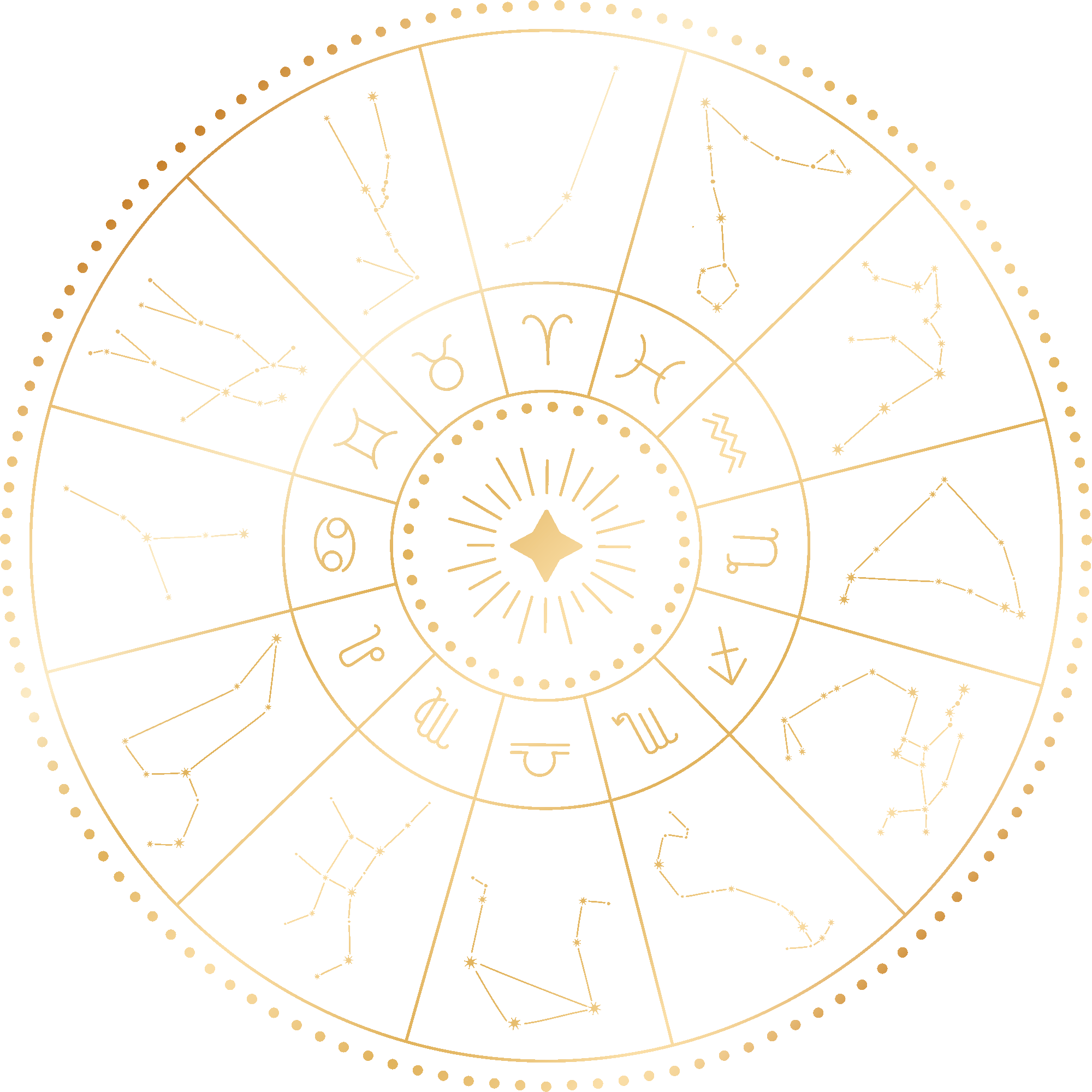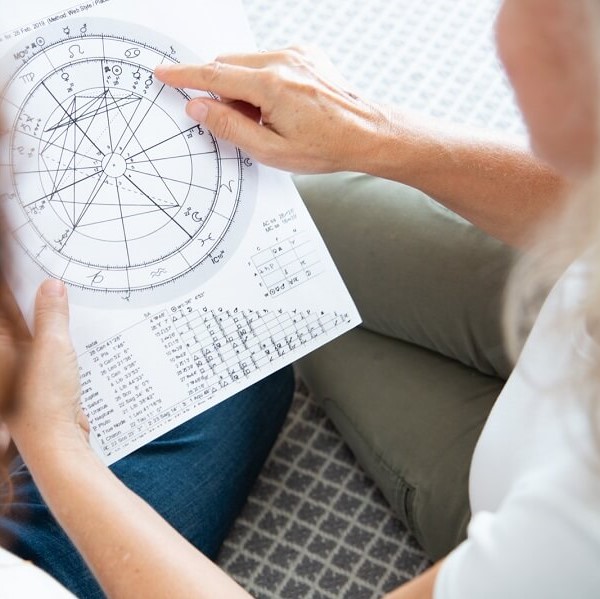To be honest, it is impossible to give an overview about astrology in general in a blog format. It is just too big a subject. That said I will try to give you a little introduction-and if the subject interests you there will be a list of literature for beginners in the end. Also at some point there will be an introduction course in astrology available.
Let`s get started
I would like to start with some basic principles of astrology. A natal astrological chart consists of much more than just your sun sign. The sun sign is the zodiac sign the sun was in when you were born. When someone asks you what your star sign is, you answer with your sun sign: ” I am a Taurus”, or “I am a Cancer”. If you know a little more you might add: “My ascendant (or rising sign) is Libra” or whatever else it might be. That is just the beginning though .We also have a Moon sign, a Mercury sign, a Venus sign, etc. In total, most astrologers use 10 planetary signs. There are many more planets and also asteroids, which some astrologers use successfully. But it can also easily get very complicated and confusing as you get a lot of information.
Planets and signs
I am working with 10 planets, and it works very well. The ones I am using are:
Sun, Moon, Mercury, Venus, Mars, Jupiter, Saturn, Uranus, Neptune and Pluto.
The planets represent different energetical aspects of your psyche. They show what part of your personality is active or gets triggered. For example, Mars represents your willpower, your ability to assert and stand up for yourself, your vitality, your sexual power, your way of expressing anger (or difficulty in doing so), etc. Depending in which zodiac sign it is placed in your natal chart it gets a "colouring", a special way how you express and live this energy. The signs show how the planetary energy is active. It also shows what motivates it to act.
To come back to the example of Mars: Let`s assume it is in Cancer. Cancer is a sign that corresponds with family, with your home, with your past / ancestry. It is very sensitive, empathic and compassionate. If the willpower, the ability to stand up and fight has a Cancer flavor it could manifest for example as somebody that stands up or defends their family, or fights for people or animals that are not able to do it themselves. It could also manifest as somebody who shows their anger mostly at home, or with close people. Or as somebody who fiercely defends their right to feel. Or all of the above. How a planet in a sign manifests itself has a lot to do with your upbringing, with your level of maturity, and of course with the rest of your chart. But however it manifests, it will be an expression of the archetypes involved.
“Astrology provides us with an extremely useful and reliable tool for understanding human nature as well as tuning in on the essence of specific interpersonal dynamics” Stephen Arroyo
Astrological houses
On top of planets and signs there are the astrological houses, 12 of them, starting with the first house at the cusp of the Ascendant. The houses are the different areas of life, such as marriage, career, home, workplace, finances etc. They determine where the “sign-flavoured planet “ is the most visible and expressed. In our example of Mars in Cancer –let’s assume it’s in the 3rd house. The 3rd house corresponds with communication in all forms: talking, listening, writing, social media, internet in general, languages, with finding your voice. It also corresponds with siblings, school and study experiences, with short trips and more. So our Mars in Cancer would for example stand up for itself and its family through words. It would maybe write a sharp letter to the school when it feels its child doesn’t get what it deserves-or show up in person at the headmaster’s office and demand a talk. It could also be in a fierce competition and continuous fight with its siblings- or the rest of the family. The possibilities are many, again depending on your level of consciousness, the aspects it makes and in general the rest of the chart. In a chart that is generally fiery and extrovert it will manifest different than in a chart that is quieter and more introvert-but you will always find the archetypes connected.

The Ascendent
The Ascendant is the sign, the constellation, which rises on the eastern horizon in the moment of your birth. All the cusps, the beginning of the houses depend on that time as well. That’s why it’s so important to know your time of birth, the more exact the better.
The Ascendant says something about your style, the way you present yourself to the world, what first impression you make on others. Often it’s visible in the way you look. Sometimes it’s mentioned in astrological literature that it is your mask- and that is true. But not in a way that it hides something, it an essential part of your personality. It’s your “vehicle” to navigate the world.
Aspects
So, this will be the last bit of practical information. Planets can also make aspects to each other. It would take a bit too much space to explain them in detail, in short aspects depend on the angle planets make to each other. There are aspects that are hard or difficult, and soft and easy ones. In the end its about inclusion, the planets in question need to work together for you to feel flowing and in harmony. To succeed in that is sometimes easier and sometimes more difficult, depending on the planets and the angle they make.
In short, a birth chart consists of:
10 planets: Sun, Moon, Mercury, Venus, Mars, Jupiter, Saturn, Uranus, Neptune and Pluto.
each one is located in one of the 12 signs of the zodiac: Aries, Taurus, Gemini etc
The Ascendant, which determines where the 1st house begins
12 houses, each representing an area of life.
The MC, IC and DC, which mark the beginning of the houses 4, 7 and 10, and again have an important meaning.
And then there are the aspects, hard and soft ones
You can see, the whole thing is quite complex and very individual…
The art of astrology is to take all these details, set priorities and create an overview. Only then you interpret the details according to their importance in their complexity. Well, and that is the difference to a computer analysis. There you may find what does a planet mean in a certain sign or house...but what it means when everything comes together is a bit much for a computer, it can only give you a lot of details. And, when faced with that many details most people are mainly confused.
An astrologer first knows what to prioritize, what detail is really important and says something fundamental about you and what detail is less important and more a supplementary information. With that done a red thread appears. Who are you, what do you need, what is your potential and how to manifest it, important goals, long term strategies and much more becomes visible.
Some thoughts about horoscopes in magazines…
In my opinion, it makes little sense to create a monthly or annual horoscope based only on the sun sign - as entertaining as that may be. And now, that you know how much more than your sun sign you are, you can understand why. It would also mean that 1/12 of humanity would go through the same process at the same time, pretty impossible. I sometimes wish these magazine horoscopes would not exist as they shed a bad light on astrology. After all, astrology is a science based on the study and experience of centuries. The first roots of astrology are from the 3rd millennium BC. But what to do…and also it makes people aware that astrology exists- and some get interested to find out more. So, I guess, in the end its good again.
Studying astrology
As you can imagine it takes a while to study astrology until you are ready to give a session. Of course, once you get started you will have a look at the charts of people close to you, and you will be able to see and point out certain aspects of it. But it takes a while to be able to really understand the archetypes behind, and set priorities –so you get a overview and can actually give really useful information. For me, it took me more than 10 years before I gave my first professional chart reading session. But I also took it as a hobby, I was very young when I started and had a lot of other things on my mind and agenda as well. At one point, after looking at many charts of friends and family members I started to see the red thread in a chart- that was an exciting moment. And made me confident to start and give sessions.

Astrological Archetypes
Astrology is based on archetypes, and the first thing to say is that no human being represents a pure archetype. We are always a mixture of different archetypes, although sometimes one archetype can be very present in your personality. Also every archetype has a shadow side and a mature and light side, and it depends on your maturity, your consciousness what side you express.
Each archetype is represented by a planet, a zodiac sign and a house.
Let's take the planet Mars again for example. As an archetype, this would be the warrior. More modern versions would be the competitive athlete or the soldier.
The planet Mars corresponds to the function of self-assertion, fiery/warlike energy, vitality, sexuality, anger.
The corresponding zodiac sign is Aries. Aries has a fiery energy, is direct, is direct, fast, impatient and impulsive, possibly easily irritated and likes to compete. He likes to lead and does not like to be told anything. Its shadow side would be the brute, the person that ignores others needs, that takes the space, that forces itself and unwelcome circumstances on others, is intimidating, angry all the time, rude, and in a fighting mode most of the time. Interesting enough it’s also the coward, the one that doesn’t dare to speak when necessary, or doesn’t dare to do the right thing. That’s the warrior spirit reversed.
The mature side would be the warrior that fights for the light, for the truth, for people who can´t do it for themselves. It is courageous, strong and uses anger wisely. A good example is Jesus angrily throwing over the tables of moneychangers. It is able to stand up for itself, to set healthy boundaries, to go for adventures and to be independent.
Wrapping it up...
Like that each planet can be seen in its archetypal nature and interpreted in the context of your natal chart.
If you understand the astrological archetypes well, that’s a big step towards being able to read a chart. They will be a part of my online course, an introduction into Astrology, that I am currently working on.
If you are interested into learning a bit more, check out my blog about the astrological elements.
